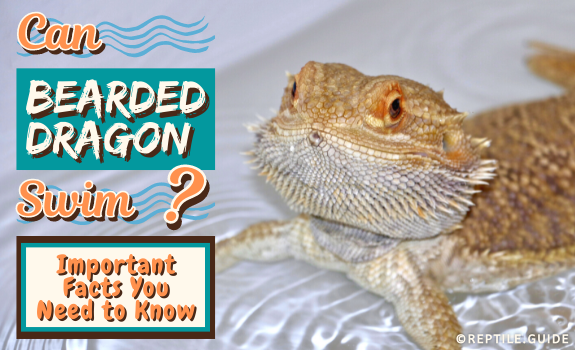The short answer is yes, bearded dragons can swim. Even though wild bearded dragons rarely encounter large bodies of water, these animals are actually natural swimmers.
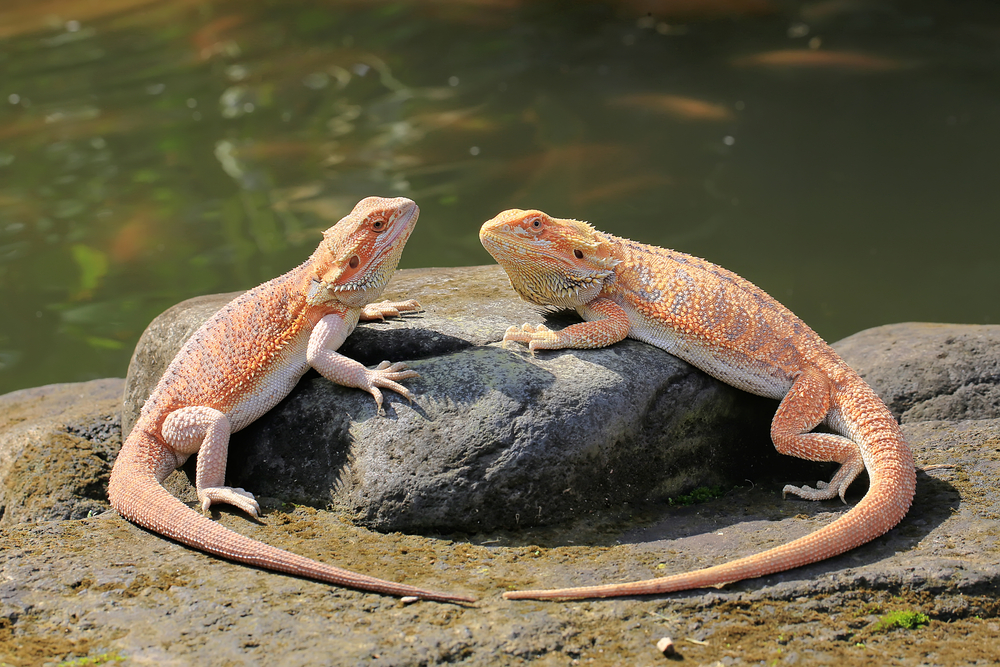
Before you build abearded dragon pool, there are some things to know about letting your bearded dragons swim. So, let’s dive into this topic!
In This Article
In Short
Many pet owners have seen videos of bearded dragons swimming, sparking a range of questions such as:
- Can bearded dragons swim?
- Do bearded dragons swim in the wild?
- Do bearded dragons like to swim?
This article will answer all those questions, as well as tell you when and where to let bearded dragons swim.
Can Bearded Dragons Swim?
Bearded dragons can swim and many bearded dragon owners allow their pets to do so under a very specific set of conditions.
You should never force a bearded dragon to swim if it doesn’t do so of its own free will.
Swimming isn’t an essential activity for these animals, and forcing them to do so may lead to injury or fatality for your beardie.
Not only can bearded dragons swim, but many of them seem to enjoy it. The key is allowing your bearded dragon to swim under supervision in clean water that’s not too cold.
If you notice your bearded dragon struggling while swimming, remove them from the water to prevent drowning.
How Do Bearded Dragons Swim?
Bearded dragons swim in a similar way to their larger relatives, the crocodiles and alligators.
Like a swimming crocodile, they fold their legs close to their bodies and propel themselves forward by moving their entire body from side to side.

When you see a bearded dragon swim, you may notice it using its tail to help with steering.
Their tails operate in much the same way as the rudder on a ship, forcing the water in a specific direction.
You may also see them giving little kicks in something akin to a ‘doggy paddle’. While they weren’t built for the water, they’re far from lost whilst swimming.
While a bearded dragon may dive underwater, you’ll mostly see your beardie swim in the shallows.
Bearded dragons are good swimmers thanks to their efficient buoyancy. They inhale air before swimming, allowing them to float on top of the water or just below the surface.
Do Bearded Dragons Like to Swim?
As with most questions regarding likes and dislikes, it largely depends on the animals themselves.
Most bearded dragons like to swim, and often a bearded dragon will take regular baths in its water bowl.
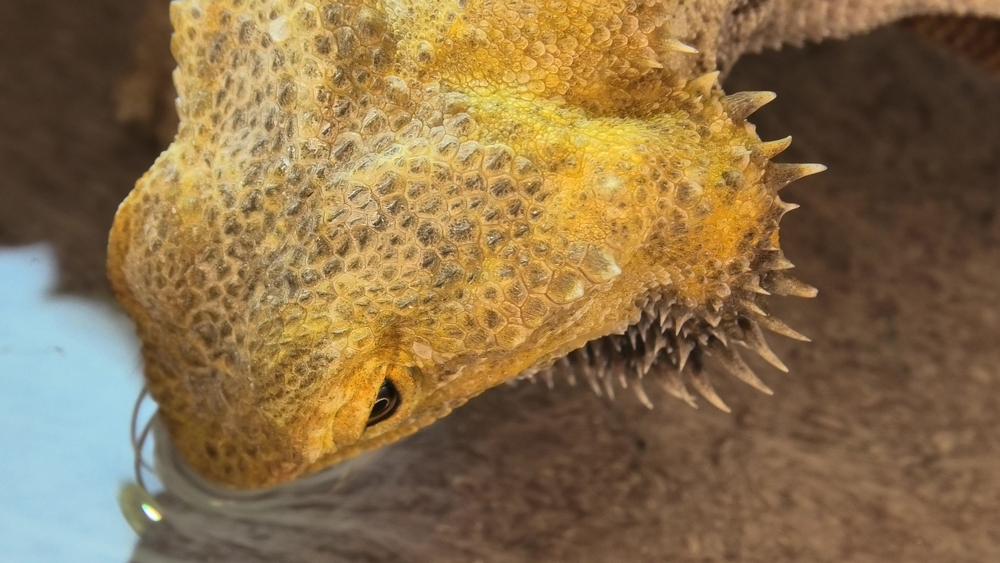
However, the bearded dragon is a cold-blooded animal from a desert environment. Not every bearded dragon swimming experiment is successful because some lizards don’t like getting wet.
Some bearded dragons swim enthusiastically and enjoy their “swim gym”. Other bearded dragons won’t touch water except to drink.
You, as a bearded dragon owner, will have to learn how your particular animal feels about swimming time.
Do Bearded Dragons Swim in the Wild?
Bearded dragons are Australian lizards that often live in desert areas. However, parts of their range also include subtropical woodlands.
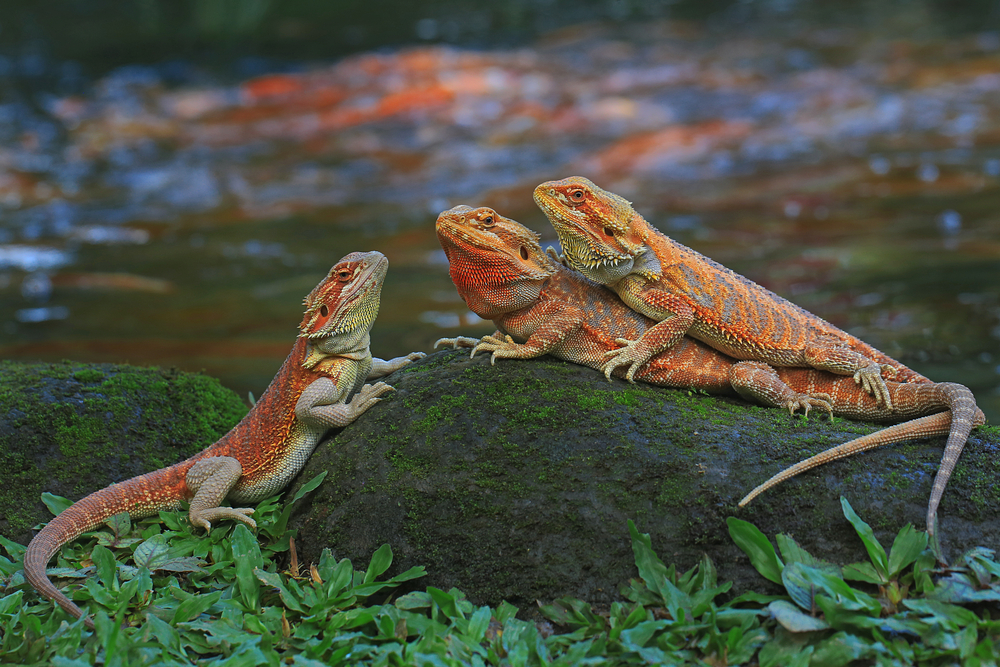
A bearded dragon’s range may include several water sources, and it’s not unusual to find swimming bearded dragons.
However, they’re not nearly as aquatic as Australian water dragons who spend a large percentage of their time in or near the water (in case their name didn’t clue you in already).
Wild bearded dragons typically only swim when necessary or if they encounter an enticing pool of warm water.
Fun Fact: Bearded dragons can’t see water. The way their type of eye works only allows them to see water if it’s moving or something is moving in it. They see the ripples, rather than the water itself.
Can a Baby Bearded Dragon Swim?
Baby bearded dragons swim as well as adults, though they should have shorter swimming sessions.
Baby bearded dragons drown easier than adults because they can’t store as much air.
You should also pay especially careful attention to the water temperature when baby bearded dragons swim in the pool.
Since they’re cold-blooded, and have little heat storage at a young age, swimming in cold water can be fatal for a baby beardie.
You should also pay careful attention if you let your baby bearded dragons swim underwater since they don’t have as much air at their disposal compared to older individuals.
Not only can bearded dragons swim, but they seem to enjoy it quite a lot!
How Deep Can Bearded Dragons Swim Underwater?
Since wild bearded dragons come from arid desert habitats, they don’t typically encounter large bodies of deep water. As such, they tend to stay near the surface when swimming.
While they can hold their breath for up to 15 minutes, they’ll rarely go deeper than around one foot.
It’s best not to let your bearded dragons swim in deep water, to help lower the risk of them drowning.
How Long Can Bearded Dragons Hold Their Breath?
When adult bearded dragons swim underwater, they can hold their breath for between 10 and 15 minutes.
Bearded dragons drown if they stay underwater for any longer than that.
Bearded dragons breathe deeply before entering the water. This gives them improved buoyancy and enough oxygen to use whilst swimming underwater.
It’s worth noting that, though baby beardies swim perfectly, they have smaller lung capacities than adults.
This means you shouldn’t let your baby bearded dragon stay underwater for longer than five minutes at a time.
Can Bearded Dragons Drown?
Despite a myth to the contrary, bearded dragons CAN drown. If they get tired, or can’t get out of the water, their lungs may fill with water and kill them.
It’s especially important to allow your bearded dragon to swim at its own pace and allow it to get out of the water when it wants to.
You also need to ensure that the beardie’s body temperature stays in the appropriate range by providing warm tap water for your bearded dragon to swim in.
Can You Resuscitate a Drowned Bearded Dragon
Theoretically, it IS POSSIBLE to revive a bearded dragon who has drowned. However, it’s better to stick to the safety guidelines and prevent drowning from occurring.
If there’s a freak accident, or your bearded dragon escapes and finds its way into a body of water, you can try to revive it by doing the following:
- Lift your bearded dragon so that it’s facing downwards. A lot of the water it has breathed in should come out.
- Massage its abdomen with swift downwards motions to help get more of the water out of its stomach and lungs.
- Use your middle and index finger to perform chest compressions. Not too hard, though, as you might break its ribs or sternum (chest bone).
- Clear away any liquid from your lizard’s mouth that may have come up from its lungs.
- Blow air into your beardies lungs through it’s mouth and remove the air from its lungs with a single chest compression. Repeat this step five to ten times.
- Check for any signs of breathing or a pulse. If nothing has happened by this point, you may want to get the beardie under a heat lamp for a while. A raised temperature may help to revive a dragon.
Occasionally, a bearded dragon may breathe in water without fully drowning.
You can hear when this has happened because its breathing makes a more bubbly sound than normal.
If you find that your bearded dragon has inhaled water:
- Try to get it to take a deep breath of air
- Place it under a heat lamp, with the dragon’s head angled downwards. The heat and gravity should help to pull the water out of its lungs.
- Get your pet to a vet immediately! It’s fundamentally important to get your lizard pal checked out and to get some meds if needed.
Respiratory Infections After Inhaling Water
If your bearded dragon has inhaled water or is recovering from drowning, you need to get it to a vet. Even if the water has come out of its lungs and stomach, it’s still at risk.
Although bearded dragons are exceptionally good swimmers, they’re not aquatic lizards. Their respiratory systems are extremely sensitive to excess moisture.
Whether it’s the wrong humidity for bearded dragons, or water washing into their lungs, increased moisture can be a serious problem.
Any bearded dragon that has inhaled water is at serious risk of respiratory infections (particularly upper respiratory infections) and even pneumonia.
You need to ask your vet to do X-rays to check for pneumonia, and they may also prescribe an antibiotic if an infection does occur.
X-rays will also help beardie owners to ensure that they haven’t accidentally fractured any of their pet’s bones while trying to revive it.
During the recovery period, you might also want to increase the temperature in the enclosure by two to four degrees to give the bearded dragon a boost while fighting any infections.
How Often Should I Allow My Bearded Dragon to Swim?
Your bearded dragon can swim around once a week.
If your pet is particularly fond of water, consider giving it a bigger water bowl so that it can have a paddle whenever it feels like it.
Bear in mind that, when swimming or wading, many bearded dragons will pass bowel movements. This means that you’ll likely need to clean the water bowl more often.
For How Long Should I Allow My Bearded Dragon to Swim?
To prevent drowning as a result of exhaustion, you should only allow your bearded dragon to swim for 10-15 minutes.
While watching your bearded dragon swim is amusing, and you might want it to carry on indefinitely, many bearded dragons get tired after 10 minutes.
Like any other animal that enjoys swimming, your beardie might want to spend more and more time in the water. It’s up to you to ensure that it doesn’t swim too often or for too long.
Can Bearded Dragons Swim in Cold Water?
Bearded dragons can swim in cold water but they should not. Their body temperature is entirely dependent on their surroundings.
Since these animals can’t heat their bodies internally, exposure to cold water can quickly lead to hypothermia and a lack of energy.
In other words, bearded dragons can swim in cold water, but there is an increased risk that may lose their ability to move – resulting in a drowned beardie.
Bearded dragons enjoy swimming and it can play an important part in environmental stimulation. However, aim to always maintain a water temperature between 90°F and 100°F.
Can bearded dragons swim in cold water? Yes, but we don’t recommend letting them. They should swim in a warm and shallow bath of tap water.
Can Bearded Dragons Swim in Saltwater?
You should never let your bearded dragon swim in saltwater of any kind.
The main problem with allowing a bearded dragon to swim in salt chlorinated pools or similar environments is that they’ll drink the saltwater.
As you know if you’ve studied bearded dragon diets, these animals aren’t equipped to deal with sodium in their diet.
In the same way as food sources high in sodium, saltwater can have a disastrous effect on your bearded dragon’s health.
Can bearded dragons swim in saltwater? Technically, yes, but they shouldn’t if you want to keep them healthy.
Can Bearded Dragons Swim in Chlorine Water?
Bearded dragons should not swim in chlorine water.
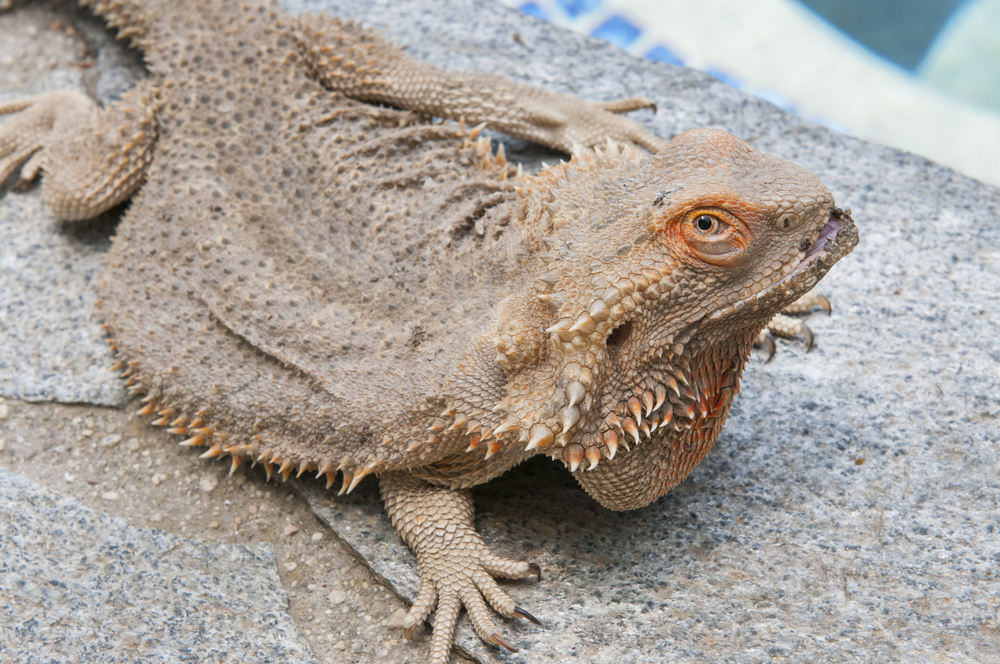
You’ve probably seen the adorable photos of bearded dragons swimming in a pool or lazing by the poolside.
However, there are several reasons why chlorinated water is bad for bearded dragons:
- It can dry out your beardie’s skin.
- Bearded dragons swim well but they also swallow some water. Depending on the concentration, chlorine water can cause toxicity in beardies.
- Chlorine irritates the eyes and can lead to infections of the mucous membranes.
So, can bearded dragons swim in chlorine water? Yes, but they should not. We strongly suggest not letting your bearded dragon swim in chlorinated or salt water pools.
Preparing a Space Where Bearded Dragons Can Swim
If you’re letting your bearded dragons swim, then you should prepare the conditions carefully so they’ll work for them. Among other things, ensure that the water:
- Isn’t too deep – A bearded dragon is more likely to drown in water over 12 inches deep
- Is the appropriate temperature – bearded dragons require a temperature of between 90°F and 100°F
- Doesn’t contain salt or chlorine – either of these chemicals may be harmful to your bearded dragon
- Has plenty of places where the bearded dragon can remove itself from the water – If your bearded dragon can’t get out when it tires, it will drown
Post-Swim Care
If your bearded dragons swim regularly, there are several things you can do to ensure that they stay healthy. Here’s how to practice bearded dragon care for your little swimmer:
- After your bearded dragon has been swimming, ensure that you towel dry them thoroughly, and let them rest under a heat lamp so they can return to their pre-swimming state.
- You can increase the temperature in the enclosure by two degrees for a few hours. Using a high-quality thermostat will help you to do that easily.
- Ensure that your bearded dragon gets enough protein in its diet and gets a high-quality bearded dragon multivitamin as an immune booster.
- Ensure that you’re using a substrate which allows the beardie to dry out, and won’t maintain moisture for extended periods.
If you’re looking for a reliable bearded dragon food and supplies online store, we recommend Chewy! It is the most trusted and convenient online destination for reptile pet owners. Click here to save 30% on your first order.
We may receive a small commission if you purchase after clicking. This does NOT change what you pay or what we recommend. It does help fund the research we put into the site, and we’re grateful for any support!
Bearded Dragon Swim Gyms
If you want the ultimate safe, and fun, swimming experience for your bearded dragons, consider a swim gym.
A swim gym, though the term is often loosely applied to bearded dragons swimming, is a dedicated bearding swimming area (like a kiddie pool or large Rubbermaid container).
By having a dedicated swimming pool for your beardie, rather than a bathtub, or some other makeshift location, you have better control of its parameters.
You can fully moderate the depth of the water and the temperature (by using a shielded aquarium heater).
Where does the gym part come from? Well, you can also add a variety of obstacles and fun activities in the water for your beardie to enjoy.
A few of the fantastic things that you can give your bearded dragon to play with include:
- Islands
- Plastic tubes
- Floating balls
- Floating lily pads
- Turtle Logs and Driftwood
You can use anything that offers environmental enrichment but isn’t harmful to the beardie. Some people go to great lengths to set up gyms for their bearded dragons.
In many ways, a swim gym is safer than regular swimming since the bearded dragon can get out in a myriad of locations.
Swim gyms also provide more exercise and enrichment than a regular swimming session would.
Pro Tip: Remember to clean the swim gym equipment regularly. Bearded dragons often pass bowel movements while swimming, and their toys may harbor salmonella bacteria.
Related Species and Articles to Bearded Dragons
If you’re interested in other bearded dragon articles and related species, have a look at:
- Bearded Dragon Lighting: everything you need to know
- How to Tell if Your Bearded Dragon Is Sick
- How Often Do You Feed a Bearded Dragon
- You can also check out our other articles on lizards – we have vital guides that you can learn from!
